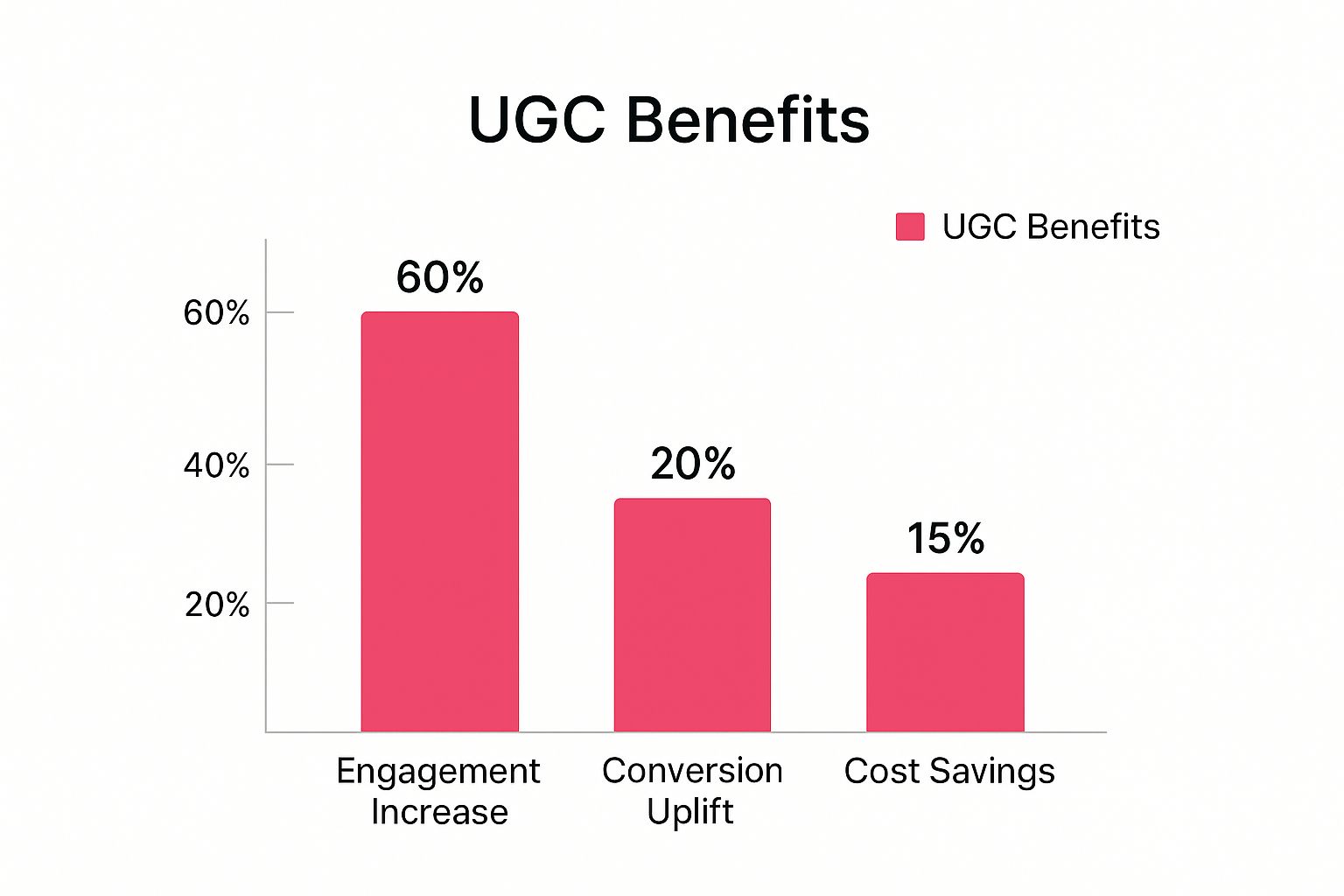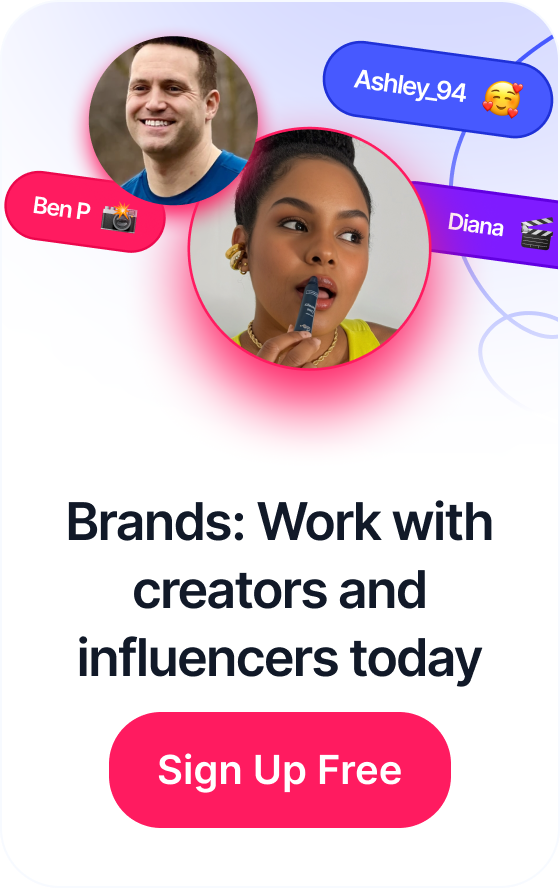 How to Find Influencer on Amazon: Boost Your Brand
How to Find Influencer on Amazon: Boost Your Brand
Table of Contents
Understanding The UGC Revolution
User-generated content (UGC) has quickly become a cornerstone of successful marketing strategies. But what's driving this shift, and why is UGC so important now? This rise in UGC is fueled by growing consumer distrust of traditional advertising. Consumers are looking for authentic experiences and recommendations from people they can relate to.
This means brands need to adapt and connect with their audience in new ways. UGC offers a solution by providing genuine, relatable content created by real people. Think about a customer posting a photo using your product or sharing a positive review on social media platforms like WordPress. This type of content carries more weight than a polished, corporate advertisement.
UGC also helps brands build trust and credibility. It's viewed as more transparent and trustworthy, leading to increased engagement and conversions. Brands using UGC see a 29% increase in web conversions compared to campaigns without it. Furthermore, 79% of people say UGC influences their purchasing decisions. This highlights the power of social proof and authentic content. For more statistics on UGC's impact, discover more insights.
Why UGC Is Transforming Marketing
UGC offers several key advantages over traditional marketing:
Cost-Effectiveness: UGC significantly reduces content production costs. Brands can leverage customer-created content instead of expensive photoshoots or video production.
Increased Engagement: UGC builds community and encourages interaction. When customers see their content featured, they feel valued and are more likely to engage further.
Improved SEO: Search engines value fresh, relevant content. UGC provides a constant stream of new material, boosting your website's search ranking.
The Future of UGC
The rise of UGC isn't a passing trend; it's a fundamental change in how brands connect with their audience. As consumers continue prioritizing authenticity and transparency, UGC's importance will only increase.
Incorporating a robust UGC strategy is no longer optional—it's essential for brands that want to thrive. This understanding helps identify strategic UGC opportunities that competitors might miss. Moving forward, brands must embrace UGC as a core element of their overall marketing strategy.
The ROI Case for User Generated Content

This infographic illustrates the advantages of a well-executed user-generated content (UGC) strategy. It highlights how integrating UGC can result in a 60% boost in engagement, a 20% increase in conversions, and 15% cost savings. These impressive statistics underscore UGC's power to positively influence your bottom line. A successful UGC strategy isn't just about creating online buzz; it's about achieving tangible business results.
This section dives into the return on investment (ROI) offered by UGC. We'll move beyond the hype and address the critical question: does UGC truly deliver? This means looking beyond surface-level engagement and focusing on the concrete numbers that showcase real business value.
Measuring UGC Success: Key Metrics That Matter
To evaluate your UGC strategy effectively, it's essential to identify the metrics that truly matter. We'll go beyond vanity metrics like likes and shares and concentrate on those directly linked to your business objectives.
- Conversion Rate: How effectively does UGC encourage customers to take desired actions, like making a purchase or subscribing to a newsletter?
- Customer Acquisition Cost (CAC): Does using UGC reduce the expense of acquiring new customers compared to traditional marketing channels?
- Customer Lifetime Value (CLV): Does UGC contribute to improved customer loyalty and increased repeat purchases, ultimately boosting CLV?
Attributing Value to UGC Formats
Different UGC formats offer unique contributions to your overall ROI. For instance, customer reviews often directly influence purchase decisions, while social media posts can elevate brand awareness and engagement.
It's crucial to understand how each format contributes to the customer journey and assign a corresponding value. This requires a nuanced understanding of both the immediate sales impact and long-term brand building effects. For further information on maximizing your influencer strategy, check out our guide on How to master influencer relationship management.
Common Mistakes in Measuring UGC Impact
Many brands make the mistake of prioritizing superficial metrics or failing to accurately attribute value to UGC. This can lead to a skewed understanding of its true influence. Simply tallying UGC posts without considering their engagement levels or influence on conversions offers little actionable insight.
Neglecting to track the long-term effects of UGC on brand perception can also undervalue its contribution to brand equity. How to Manage Influencer Relationships provides more details on effectively managing influencer collaborations.
The following table helps to compare and contrast the benefits of UGC and traditional marketing approaches.
UGC vs. Traditional Content Marketing
A comparison of user generated content and traditional brand-created content across key metrics
| Metric | User Generated Content | Traditional Brand Content |
|---|---|---|
| Authenticity | High | Can be perceived as less authentic |
| Cost | Lower | Higher |
| Engagement | Higher (up to 60% increase) | Lower |
| Conversion Rate | Higher (up to 20% uplift) | Lower |
| Reach | Can be viral | Dependent on ad spend |
As you can see, UGC offers distinct advantages over traditional methods, particularly in terms of authenticity, cost, and engagement.
The UGC market has seen significant growth, reaching over $7.6 billion in 2025, a 69% surge from $4.5 billion in 2024. This expansion is driven by tighter marketing budgets and a growing consumer preference for authentic content. Find more detailed statistics here.
Long-Term Brand Equity and UGC
While the immediate performance benefits of UGC are noteworthy, its long-term impact on brand equity is equally significant. By nurturing authentic customer connections and building a strong brand community, UGC reinforces your brand identity and cultivates loyalty. This translates into sustainable growth and a lasting competitive advantage.
Crafting Your UGC Framework That Actually Works
Stop gathering random customer content and start building a strategic user-generated content (UGC) strategy. This section offers a practical blueprint for a UGC system that consistently delivers results. We'll explore how to align UGC initiatives with your business objectives, from building awareness to optimizing conversions, by drawing on insights from content strategists at successful brands.
Aligning UGC With Your Business Goals
A robust UGC strategy begins with clearly defined objectives. Ask yourself what you want to achieve with UGC. Are you aiming to boost brand awareness, drive sales, or build a stronger community? Each objective requires a different approach.
For example, if increasing brand visibility is your goal, you might focus on encouraging customers to share photos of your product on social media using a branded hashtag. However, if conversions are your target, showcasing customer testimonials and reviews on your product pages might be more effective.
Establishing Clear Participation Guidelines
Creating clear participation guidelines ensures the UGC you collect aligns with your brand identity and messaging. These guidelines should outline the type of content you’re looking for, any specific requirements (e.g., video length, image resolution), and any restrictions (e.g., content that is offensive or promotes competitors).
Maintaining brand standards while encouraging authentic contributions is key. Think of it like providing a canvas and some paints but letting your customers create their own unique masterpieces.
Designing a Seamless Submission Process
The easier it is for customers to submit their content, the more UGC you'll receive. Minimize friction in the submission process by providing multiple submission options, such as a dedicated hashtag, a submission form on your website, or direct messaging on social media. You might be interested in: How to find microinfluencers to further expand your content reach.
A streamlined process will encourage greater participation and a wider variety of content.
Navigating Rights Management
Protecting both creators and your brand requires a robust rights management protocol. Clearly communicate how you intend to use customer content and obtain the necessary permissions. This not only builds trust with your audience but also avoids potential legal issues.
Transparency is paramount. Imagine borrowing a friend’s car – you wouldn't just assume it’s okay; you'd ask first. The same principle applies to UGC.
Adaptable Frameworks and Practical Examples
Different industries and target audiences require different UGC frameworks. A beauty brand, for example, might focus on visual content like makeup tutorials and product demonstrations, while a software company might encourage users to share tips and tricks for using their product. This adaptability ensures your UGC strategy resonates with your specific target audience.
Here's an example of a UGC brief that has generated exceptional content:
Brand: A sustainable clothing company
Objective: Increase brand awareness and showcase the versatility of their clothing line.
UGC Brief: Ask customers to share photos of themselves wearing the brand's clothing in different settings, using the hashtag #SustainableStyle. Offer a prize for the most creative and inspiring submissions.
This type of brief encourages customers to become brand ambassadors and provides valuable social proof for potential new customers. It also provides the brand with a wealth of authentic content that can be used across various marketing channels. By carefully crafting your UGC framework and providing clear guidelines, you can transform random customer content into a powerful engine for growth.

Platform-Specific UGC Tactics That Convert

A successful user-generated content (UGC) strategy hinges on understanding the unique nature of each platform. What thrives on Instagram might not work on TikTok, and LinkedIn requires a different approach altogether. This means tailoring your UGC strategy to each platform for the best results. A content calendar can help maintain consistent, engaging content. For tips on creating one, check out this helpful article: create a social media content calendar.
Deciphering The Nuances of Each Platform
Each platform has its own UGC strengths and weaknesses. Understanding these nuances is crucial for maximizing your results. Instagram, for example, thrives on visual content like high-quality images and short videos. TikTok, on the other hand, favors short-form videos, often incorporating music and creative editing.
LinkedIn, as a professional network, prefers text-based content, articles, and thought leadership. Recognizing these differences lets you create the right content for the right audience on the right platform. For further guidance on content strategy, see our guide on How to master influencer marketing best practices.
Optimizing UGC Formats For Maximum Impact
Different UGC formats perform better on different platforms. High-quality images, short videos, and Stories work well on Instagram. TikTok prefers short, engaging videos using trending sounds and hashtags. LinkedIn thrives on text-based content, articles, and professional insights. Adapting your UGC to these formats increases visibility and engagement.
The following table provides a summary of platform-specific UGC performance metrics:
"Platform-Specific UGC Performance Metrics" provides key performance indicators and benchmarks for UGC across different social media platforms.
| Platform | Top UGC Formats | Engagement Rate | Conversion Impact | Key Considerations |
|---|---|---|---|---|
| High-quality images, short videos, Stories | Varies depending on industry and audience | Can be challenging to drive direct traffic | Focus on visually appealing content and strong community engagement | |
| TikTok | Short, engaging videos with trending sounds and hashtags | Potentially very high due to viral nature | Can be difficult to track long-term impact | Leverage trends and challenges for maximum reach |
| Text-based content, articles, professional insights | Generally lower than other platforms, but highly targeted | Can drive leads and build professional credibility | Focus on valuable content and thought leadership |
This table highlights the importance of tailoring your UGC strategy to each platform. While TikTok offers the potential for viral reach, LinkedIn provides a more targeted approach for professional audiences. Instagram falls somewhere in between, offering strong visual engagement and community building opportunities.
Posting Frequency and Algorithmic Performance
Understanding each platform’s algorithm is essential. Instagram prioritizes high-quality visuals and consistent posting. TikTok rewards creativity and engagement with trending sounds and challenges. LinkedIn favors thought leadership and professional networking. Adjusting your posting frequency and content style to each platform’s algorithm maximizes reach.
Maintaining Platform Authenticity and Cross-Channel Cohesion
While tailoring your approach to each platform is important, maintaining a consistent brand voice and messaging across all channels is equally crucial. This creates a cohesive brand experience, regardless of where your audience interacts with you. Balancing platform-specific tactics and overall brand consistency is key.
Addressing Platform Limitations
Every platform has its limitations. Instagram can be challenging for driving direct website traffic. TikTok videos are short-lived and can quickly disappear. LinkedIn, while excellent for professional networking, might be less effective for reaching younger demographics. Acknowledging these limitations and finding workarounds is vital. Instagram Stories, for instance, can effectively drive traffic, while TikTok success relies on creating viral content.
Inspiring High-Value Content Creation

The success of your user-generated content (UGC) strategy depends heavily on inspiring high-quality contributions. The difference between a so-so campaign and a truly exceptional one often comes down to how you motivate authentic participation. This means going beyond simple incentives and truly understanding what drives meaningful engagement.
Understanding Your Audience and Crafting Resonant Prompts
Effective UGC strategies begin with a deep understanding of your target audience. What makes them tick? What are their passions and priorities? For example, a campaign aimed at outdoor enthusiasts might use prompts that encourage sharing adventure stories and breathtaking nature photography.
On the other hand, a campaign geared towards business professionals might focus on prompts related to sharing career advice or industry insights. Crafting prompts that truly resonate with your audience is crucial for inspiring high-quality content. These prompts should be clear, concise, and easy to understand, while also aligning with your brand's values and overall messaging.
Designing Natural Participation Mechanics
The process of participating should feel organic and integrated into the user experience. It shouldn't feel forced or disruptive. For example, integrating a smooth photo upload feature directly within your product page makes sharing customer experiences effortless.
In contrast, requiring users to navigate complex steps or complete lengthy forms can create friction and discourage participation. Think of it like hosting a party: you want to create a welcoming environment where guests feel comfortable interacting, not one where they feel pressured to participate in specific activities.
Reward Structures That Prioritize Quality
While incentives can be useful, they should prioritize quality over quantity. Instead of simply rewarding the most frequent contributors, focus on recognizing and rewarding the most creative, insightful, and engaging content. This approach encourages users to put more effort into their contributions, which in turn elevates the overall quality of your UGC.
Balancing Structure With Creative Freedom
Successful brands understand the importance of balancing structure and creative freedom. Clear guidelines and well-defined prompts are essential. However, giving users the space to express themselves is equally important. This balance fosters authenticity and encourages a wider range of diverse and engaging content.
Handling Low Participation Scenarios and Maintaining Content Standards
Low participation can be a hurdle in any UGC strategy. If this happens, consider partnering with micro-influencers or brand ambassadors to seed content and inspire broader participation. Maintaining content standards is also essential for protecting your brand image.
Establish clear guidelines for acceptable content and implement a moderation process to ensure all UGC aligns with your brand values. However, strike a balance – avoid overly strict moderation that stifles creativity or dampens enthusiasm.
Tactical Approaches for Different Audience Types
Different audience types require different tactical approaches. Enthusiast communities, for instance, might be motivated by opportunities to connect with like-minded individuals and share their passion. Skeptical professionals, however, may require more data-driven evidence and testimonials to build trust and encourage participation. Adapting your strategy to the specific characteristics of your target audience is vital for success.
Integrating UGC Throughout the Customer Journey
Strategically incorporating user-generated content (UGC) can transform everyday content into valuable assets that boost conversions. This exploration delves into how successful brands connect specific UGC formats to each phase of the customer journey, from initial awareness to dedicated brand advocacy. It all begins with understanding how diverse types of user content can meet customer needs and address concerns at pivotal decision points.
Awareness Stage: Sparking Interest and Discovery
At the awareness stage, the primary goal is to introduce your brand and its offerings to potential customers. UGC plays a crucial role in capturing attention and building that initial spark of interest.
Eye-Catching Visuals: Compelling images and short-form videos shared on platforms like Instagram and TikTok can effectively showcase your products in action. Imagine vibrant photos of customers enjoying your product or engaging unboxing videos.
Influencer Collaborations: Partnering with relevant influencers can introduce your brand to a wider audience, leveraging trusted voices to build credibility.
Consideration Stage: Educating and Building Trust
Once potential customers are aware of your brand, the consideration stage focuses on providing information that helps them evaluate your products or services.
Product Reviews and Testimonials: Authentic customer reviews and testimonials displayed on your website or product pages build trust and address potential hesitations. Reading positive experiences from others can be a powerful motivator.
Informative Videos: User-created tutorials or how-to videos demonstrating your product's features and benefits can be highly effective in educating potential buyers.
Blog Posts & Articles: Longer-form content crafted by users with in-depth product experience can provide valuable insights.
Decision Stage: Encouraging Conversions
The decision stage is the moment of truth – when potential customers are poised to make a purchase. Here, UGC can offer the final encouragement they need to convert.
Customer Testimonials: Showcasing positive customer experiences near the point of purchase can significantly influence conversion rates.
User-Generated Comparisons: Content comparing your product to competitors, emphasizing its strengths, can be particularly persuasive.
Limited-Time Offers and Promotions: Integrating UGC into your promotional campaigns can increase their engagement and relatability.
Advocacy Stage: Turning Customers into Brand Ambassadors
After a purchase, the advocacy stage concentrates on nurturing customer loyalty and inspiring them to become brand advocates.
Social Sharing Contests: Hosting contests that encourage customers to share their product experiences on social media can generate substantial buzz and expand your reach.
Loyalty Programs: Rewarding customers for creating and sharing UGC cultivates a sense of community and strengthens their bond with your brand.
Creating a Seamless UGC Journey
A successful UGC strategy isn't solely about using various content formats at different stages; it's about crafting a seamless and cohesive customer journey. This involves maintaining a consistent brand experience across all touchpoints and providing clear calls to action that guide customers through the sales funnel.
Adapting and Optimizing Your UGC Ecosystem
Continuously evaluate the performance of your UGC at each stage and adjust your strategy as needed. Monitor key metrics like engagement, conversion rates, and customer feedback to understand what resonates and identify areas for improvement. This data-driven approach ensures your UGC remains relevant and effective in driving business results. Regularly reviewing and refining your strategy is essential for staying ahead of the curve and maximizing the impact of your UGC efforts.
Measuring What Matters in Your UGC Strategy
A successful user-generated content (UGC) strategy requires more than just a large volume of content. It demands a thorough understanding of what resonates with your audience and drives tangible results. This means shifting focus away from superficial metrics like likes and shares, and prioritizing key performance indicators (KPIs) that truly reflect business impact.
Essential KPIs for UGC Success
A robust measurement framework should consider KPIs across several key areas:
Engagement: Track metrics like likes, comments, shares, and click-through rates to understand how your audience interacts with UGC. Higher engagement often indicates resonant content and a thriving community.
Conversion: Monitor conversions directly linked to UGC, such as purchases or sign-ups. This data demonstrates how effectively UGC influences customer behavior.
Sentiment: Analyze the emotional tone of UGC to understand audience perception of your brand. Positive sentiment often suggests a strong brand image and customer satisfaction.
Cost Efficiency: Compare the cost of customer acquisition through UGC against other marketing channels. This analysis can reveal the potential for cost savings with UGC.
Setting Benchmarks and Tracking Progress
Establish realistic benchmarks aligned with industry averages and your brand's specific objectives. For instance, you might target a 10% increase in conversion rate within three months of launching your UGC campaign. Regularly monitor your progress against these benchmarks to identify areas for improvement and adjust your strategy accordingly.
Attribution Models for Complex Customer Journeys
Customer journeys rarely follow a linear path. They often involve multiple touchpoints across various channels, making it difficult to isolate the impact of UGC. Implement attribution models that assign weighted value to each interaction, acknowledging that UGC may play a supporting role alongside other marketing efforts. This nuanced approach provides a more accurate understanding of UGC's contribution to the overall customer journey.
Designing Testing Protocols for Continuous Improvement
Data-driven optimization is crucial for a successful UGC strategy. Design A/B tests to compare different UGC formats, calls to action, or platform strategies. For instance, compare the effectiveness of customer testimonials versus influencer-generated content in driving conversions. Analyzing these test results offers valuable insights for continuous improvement.
Building Effective Reporting Systems
Develop reporting systems that clearly communicate the impact of your UGC strategy to key stakeholders. Utilize dashboards to visualize key metrics and showcase successes. Data transparency helps secure ongoing support and buy-in for UGC initiatives.
Tools and Resources for UGC Measurement
Various tools can assist in measuring and analyzing UGC performance:
Social Media Analytics Platforms: Leverage native platform analytics (such as those provided by Facebook, Instagram, and TikTok) to track engagement metrics and identify trending content.
UGC Platforms: Dedicated UGC platforms often provide built-in analytics dashboards for tracking performance across multiple channels. JoinBrands is one example of a platform that offers these capabilities.
Marketing Analytics Suites: Comprehensive marketing analytics tools like Google Analytics can integrate UGC data with other marketing data for a holistic performance overview.
By focusing on relevant metrics and establishing a robust measurement framework, you can demonstrate the true value of your UGC strategy and continuously optimize for maximum impact. Ready to enhance your creator marketing? JoinBrands offers a comprehensive platform to connect with a network of creators, streamline campaign management, and accelerate sales growth.








